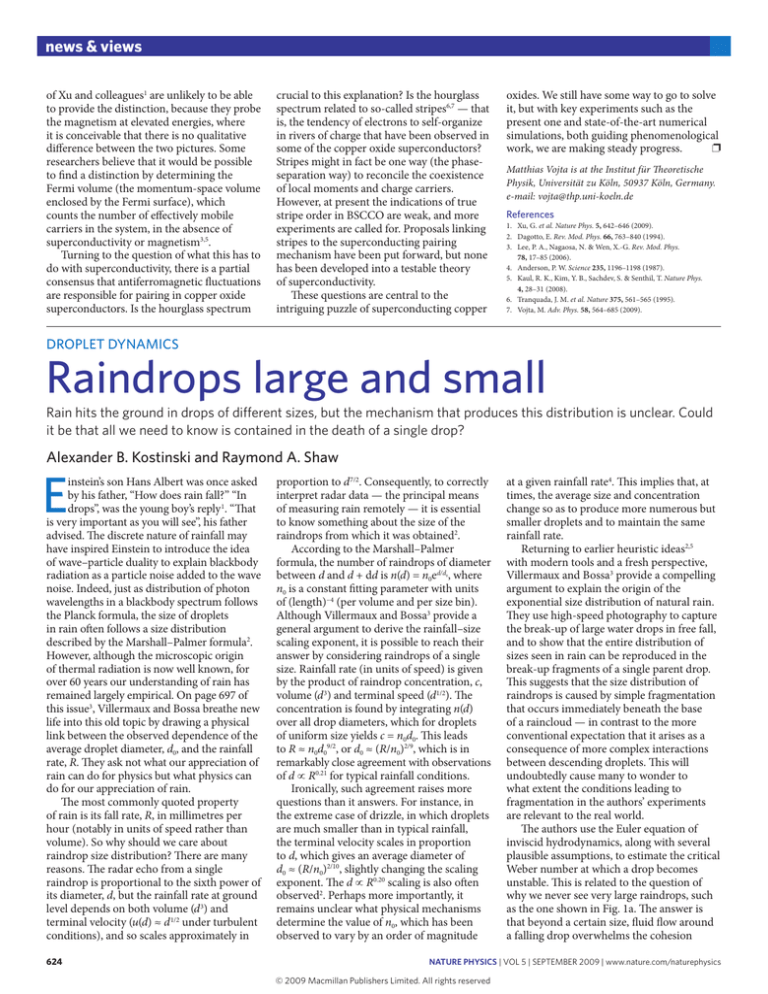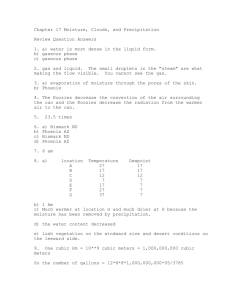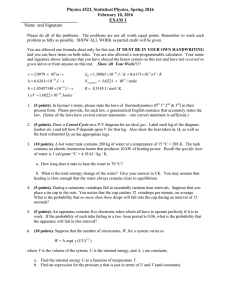
news & views
of Xu and colleagues1 are unlikely to be able
to provide the distinction, because they probe
the magnetism at elevated energies, where
it is conceivable that there is no qualitative
difference between the two pictures. Some
researchers believe that it would be possible
to find a distinction by determining the
Fermi volume (the momentum-space volume
enclosed by the Fermi surface), which
counts the number of effectively mobile
carriers in the system, in the absence of
superconductivity or magnetism3,5.
Turning to the question of what this has to
do with superconductivity, there is a partial
consensus that antiferromagnetic fluctuations
are responsible for pairing in copper oxide
superconductors. Is the hourglass spectrum
crucial to this explanation? Is the hourglass
spectrum related to so-called stripes6,7 — that
is, the tendency of electrons to self-organize
in rivers of charge that have been observed in
some of the copper oxide superconductors?
Stripes might in fact be one way (the phaseseparation way) to reconcile the coexistence
of local moments and charge carriers.
However, at present the indications of true
stripe order in BSCCO are weak, and more
experiments are called for. Proposals linking
stripes to the superconducting pairing
mechanism have been put forward, but none
has been developed into a testable theory
of superconductivity.
These questions are central to the
intriguing puzzle of superconducting copper
oxides. We still have some way to go to solve
it, but with key experiments such as the
present one and state-of-the-art numerical
simulations, both guiding phenomenological
work, we are making steady progress.
❐
Matthias Vojta is at the Institut für Theoretische
Physik, Universität zu Köln, 50937 Köln, Germany.
e-mail: vojta@thp.uni-koeln.de
References
1. Xu, G. et al. Nature Phys. 5, 642–646 (2009).
2. Dagotto, E. Rev. Mod. Phys. 66, 763–840 (1994).
3. Lee, P. A., Nagaosa, N. & Wen, X.-G. Rev. Mod. Phys.
78, 17–85 (2006).
4. Anderson, P. W. Science 235, 1196–1198 (1987).
5. Kaul, R. K., Kim, Y. B., Sachdev, S. & Senthil, T. Nature Phys.
4, 28–31 (2008).
6. Tranquada, J. M. et al. Nature 375, 561–565 (1995).
7. Vojta, M. Adv. Phys. 58, 564–685 (2009).
DROPLET DYNAMICS
Raindrops large and small
Rain hits the ground in drops of different sizes, but the mechanism that produces this distribution is unclear. Could
it be that all we need to know is contained in the death of a single drop?
Alexander B. Kostinski and Raymond A. Shaw
E
instein’s son Hans Albert was once asked
by his father, “How does rain fall?” “In
drops”, was the young boy’s reply 1. “That
is very important as you will see”, his father
advised. The discrete nature of rainfall may
have inspired Einstein to introduce the idea
of wave–particle duality to explain blackbody
radiation as a particle noise added to the wave
noise. Indeed, just as distribution of photon
wavelengths in a blackbody spectrum follows
the Planck formula, the size of droplets
in rain often follows a size distribution
described by the Marshall–Palmer formula2.
However, although the microscopic origin
of thermal radiation is now well known, for
over 60 years our understanding of rain has
remained largely empirical. On page 697 of
this issue3, Villermaux and Bossa breathe new
life into this old topic by drawing a physical
link between the observed dependence of the
average droplet diameter, d0, and the rainfall
rate, R. They ask not what our appreciation of
rain can do for physics but what physics can
do for our appreciation of rain.
The most commonly quoted property
of rain is its fall rate, R, in millimetres per
hour (notably in units of speed rather than
volume). So why should we care about
raindrop size distribution? There are many
reasons. The radar echo from a single
raindrop is proportional to the sixth power of
its diameter, d, but the rainfall rate at ground
level depends on both volume (d 3) and
terminal velocity (u(d) ≈ d 1/2 under turbulent
conditions), and so scales approximately in
624
proportion to d 7/2. Consequently, to correctly
interpret radar data — the principal means
of measuring rain remotely — it is essential
to know something about the size of the
raindrops from which it was obtained2.
According to the Marshall–Palmer
formula, the number of raindrops of diameter
between d and d + dd is n(d) = n0ed/d , where
n0 is a constant fitting parameter with units
of (length)−4 (per volume and per size bin).
Although Villermaux and Bossa3 provide a
general argument to derive the rainfall–size
scaling exponent, it is possible to reach their
answer by considering raindrops of a single
size. Rainfall rate (in units of speed) is given
by the product of raindrop concentration, c,
volume (d 3) and terminal speed (d 1/2). The
concentration is found by integrating n(d)
over all drop diameters, which for droplets
of uniform size yields c = n0d0. This leads
to R ≈ n0d09/2, or d0 ≈ (R/n0)2/9, which is in
remarkably close agreement with observations
of d ∝ R0.21 for typical rainfall conditions.
Ironically, such agreement raises more
questions than it answers. For instance, in
the extreme case of drizzle, in which droplets
are much smaller than in typical rainfall,
the terminal velocity scales in proportion
to d, which gives an average diameter of
d0 ≈ (R/n0)2/10, slightly changing the scaling
exponent. The d ∝ R0.20 scaling is also often
observed2. Perhaps more importantly, it
remains unclear what physical mechanisms
determine the value of n0, which has been
observed to vary by an order of magnitude
0
at a given rainfall rate4. This implies that, at
times, the average size and concentration
change so as to produce more numerous but
smaller droplets and to maintain the same
rainfall rate.
Returning to earlier heuristic ideas2,5
with modern tools and a fresh perspective,
Villermaux and Bossa3 provide a compelling
argument to explain the origin of the
exponential size distribution of natural rain.
They use high-speed photography to capture
the break-up of large water drops in free fall,
and to show that the entire distribution of
sizes seen in rain can be reproduced in the
break-up fragments of a single parent drop.
This suggests that the size distribution of
raindrops is caused by simple fragmentation
that occurs immediately beneath the base
of a raincloud — in contrast to the more
conventional expectation that it arises as a
consequence of more complex interactions
between descending droplets. This will
undoubtedly cause many to wonder to
what extent the conditions leading to
fragmentation in the authors’ experiments
are relevant to the real world.
The authors use the Euler equation of
inviscid hydrodynamics, along with several
plausible assumptions, to estimate the critical
Weber number at which a drop becomes
unstable. This is related to the question of
why we never see very large raindrops, such
as the one shown in Fig. 1a. The answer is
that beyond a certain size, fluid flow around
a falling drop overwhelms the cohesion
nature physics | VOL 5 | SEPTEMBER 2009 | www.nature.com/naturephysics
© 2009 Macmillan Publishers Limited. All rights reserved
news & views
a
b
7 mm
5 mm
3 mm
© NASA
of surface tension (Fig. 1b). This can be
visualized in terms of a capillary length —
about 3 mm for the air–water interface.
The Weber number compares inertia with
surface cohesion: We = (ρau2d)/σ, where ρa
and σ are the air density and surface tension,
respectively. Thus, We can be viewed as
a squared ratio of drop size and capillary
length. Villermaux and Bossa3 arrive at a
critical Weber number of six (Fig. 1b), which
translates to a critical drop diameter of about
6 mm, consistent with their observations and
those of others6.
In this respect, reports of very large
raindrops of up to 1 cm in diameter in
Brazilian and Hawaiian clouds are interesting
and puzzling 7. Surfactants, such as those
produced by forest fires, complicate
the situation and have been detected in
raindrops8, but their presence should lower
the surface tension and therefore the Weber
number. On the other hand, they are likely
to promote coalescence of such ‘softer’
raindrops on the way down.
Terminal speed is an important parameter
when applying Villermaux and Bossa’s
critical Weber numbers to natural rain,
particularly because speed increases with
drop size. In that respect, the perspective
of Villermaux and Bossa is complemented
by the recent findings that not all raindrops
fall at their terminal speed9. Some break the
speed limit by an order of magnitude in the
immediate aftermath of fragmentation, by
ejected smaller droplets that momentarily
maintain the momentum of their parent
drops. Such ‘superterminal’ drops were
caught on camera before they had a chance
to relax to their terminal speed (which takes
only a fraction of a second), and thereby
corroborate the break-up mechanism. This
may allow for further study and testing of
the Villermaux and Bossa perspective. In
particular, it could address longstanding
questions about whether break-up is
1 mm
Figure 1 | Raindrops under stress. a, Giant raindrops such as the one shown here, held by astronaut
Don Pettit on the space shuttle, are not observed in the atmosphere because of the deformation and
subsequent instability experienced by a terrestrial raindrop falling through air at its terminal speed, u
(reached when the gravitational force is balanced by air resistance). b, Deformation of falling drops is
determined by competition between surface tension and fluid stresses. As a result, asphericity increases
with drop size. The opposition between aerodynamic stress ρau2 and the surface tension σ is captured
by the Weber number We = (ρau2d)/σ. The critical We number of six derived by Villermaux and Bossa3,
above which spontaneous drop break-up occurs, can be motivated by equating the spherical-drop surface
energy density to inertial energy density as (σπd2)/(πd3/6) = ρau2.
predominantly spontaneous, as they suggest,
or the result of collisions between drops,
which is the common view.
Remote sensing has much to contribute
here. For example, perhaps drop oscillations
between prolate and oblate asphericity
(preceding the break-up) are the source
of the surprising depolarization of radar
or lidar waves that has been observed at
vertical incidence10. Also, returning to radar
meteorology, the d 6 dependence of the
radar echo suggests that the Villermaux and
Bossa3 vision of progressive refinement of
the size distribution below the cloud base
can be tested by studying radar reflectivity
versus height with high spatial resolution.
Natural rainfall still has something to teach
us, so let it rain.
❐
Alexander B. Kostinski and Raymond A. Shaw
are in the Department of Physics, Michigan
Technological University, 1400 Townsend Drive,
Houghton, Michigan 49931, USA.
e-mail: alex_kostinski@mtu.edu; rashaw@mtu.edu
References
1. Chiu, C.-L. (ed.) Stochastic Hydraulics 10 (Univ. Pittsburgh, 1971).
2. Rogers, R. R. & Yau, M. K. A Short Course in Cloud Physics
(Pergamon, 1989).
3. Villermaux, E. & Bossa, B. Nature Phys. 5, 697–702 (2009).
4. Waldvogel, A. J. Atmos. Sci. 31, 1067–1078 (1974).
5. Langmuir, I. J. Meteorol. 5, 175–192 (1948).
6. Clift, R., Grace, J. R. & Weber, M. E. Bubbles, Drops and Particles
346 (Dover, 2005).
7. Hobbs, P. V. & Rangno, A. L. Geophys. Res. Lett. 31, L13102 (2004).
8. Taraniuk, I., Kostinski, A. B. & Rudich, Y. Geophys. Res. Lett.
35, L19810 (2008).
9. Montero-Martinez, G., Kostinski, A. B., Shaw, R. A. &
Garcia-Garcia, F. Geophys. Res. Lett. 36, L11818 (2009).
10. Jameson, A. R. & Durden, S. L. J. Appl. Meteor. 35, 271–277 (1996).
HEAVY ELECTRONS
The gathering storm of data
The nature of the ‘hidden order’ in URu2Si2 has resisted characterization for the past twenty-five years. Recent
photoemission results report the observation of a narrow heavy-fermion band that sharpens below the mysterious
transition and provides new clues about its origins.
P. Chandra and P. Coleman
T
he electronic applications of
tomorrow will probably not be direct
extensions of what we know today,
but will more likely depend on principles of
electron organization in matter, which we
are only beginning to discover. Physicists
are just starting to appreciate the rich fabric
of the periodic table and the vast diversity
of electronic behaviour that can be shown
by different compounds. Although practical
nature physics | VOL 5 | SEPTEMBER 2009 | www.nature.com/naturephysics
© 2009 Macmillan Publishers Limited. All rights reserved
applications of emergent phenomena
such as superconductivity or magnetism
require materials in which these states
occur at, or above, room temperature,
the unusual electronic correlations and
625







